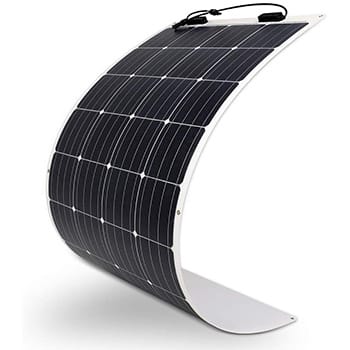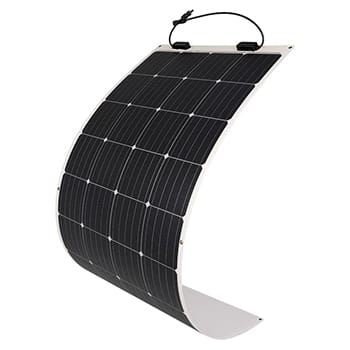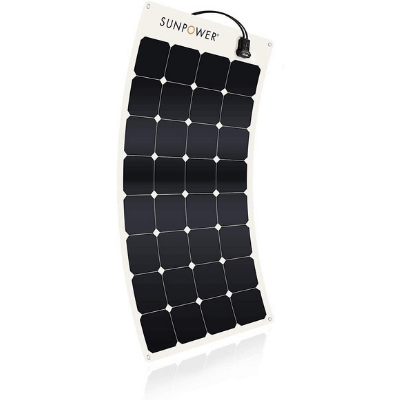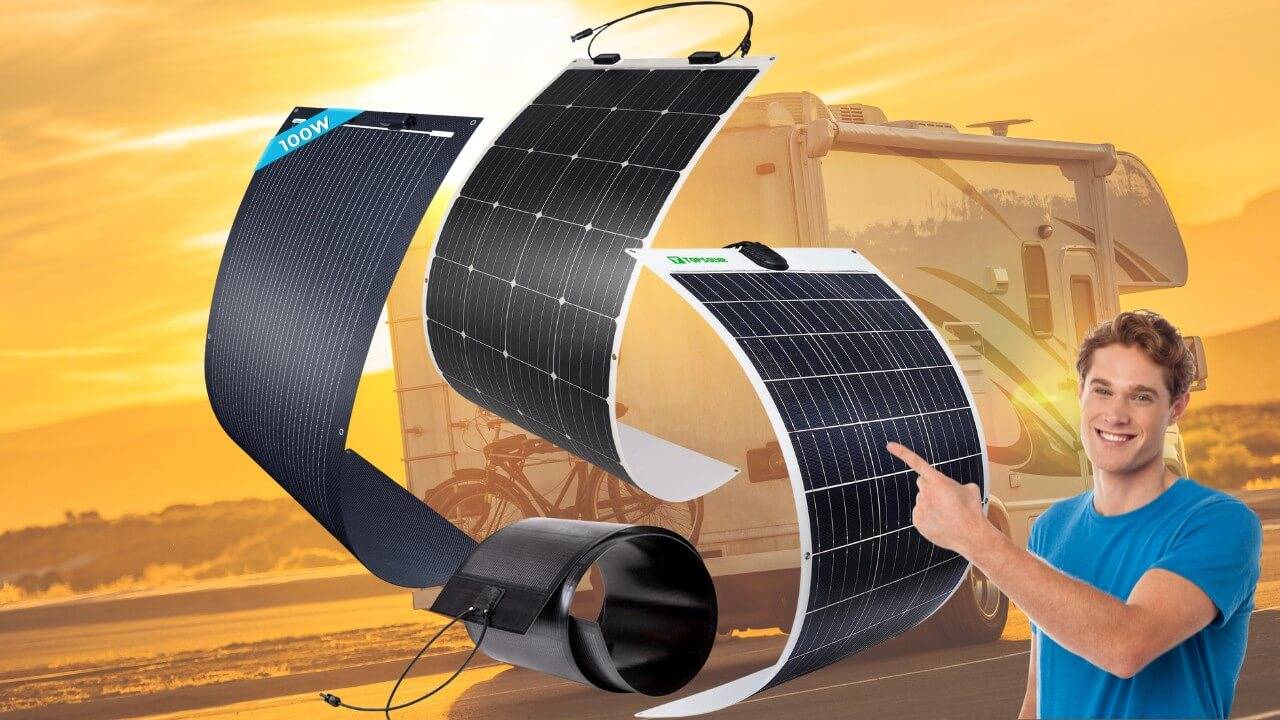Ever wished solar panels weren’t so bulky and rigid? What if you could power your RV, boat, or even a tent with lightweight, bendable solar panels? That’s exactly what flexible solar panels offer—a portable, easy-to-install alternative to traditional solar systems.
Unlike conventional panels, these ultra-thin solar sheets can bend to fit curved surfaces, making them perfect for off-grid adventures, small spaces, and creative energy solutions.
But are they the right choice for you?
In this guide, we’ll explore everything you need to know about flexible solar panels—how they work, their benefits, and the factors to consider before buying one. We’ll also cover how to mount and maintain them properly, plus a look at the best eco-friendly flexible solar panel brands.
Whether you’re new to solar power or looking for a more adaptable solution, this blog will help you make an informed decision.
What Are Flexible Solar Panels?

Flexible solar panels are lightweight, bendable photovoltaic modules designed to generate electricity while conforming to curved or uneven surfaces.
Unlike traditional rigid panels, they use thin-film solar technology or ultra-light crystalline silicon, making them more adaptable for RVs, boats, vehicles, off-grid cabins, and portable energy solutions.
These panels are typically thinner and more versatile, with some models capable of rolling or folding for easy transport and storage.
They are manufactured using a roll-to-roll printing process, allowing for cost-effective mass production in various sizes, wattages, and shapes. While they tend to have lower efficiency than conventional solar panels, their portability and lightweight design make them a popular choice for mobile and off-grid applications.
Which Type of Flexible Solar Panel Is Best for You?
Flexible solar panels come in two primary types:
- Crystalline silicon solar panels
- Thin-film solar panels
Each has distinct advantages, trade-offs, and ideal use cases. Understanding these differences will help you choose the best flexible solar panel for your needs.
Crystalline Silicon Flexible Solar Panels

Recognizable by their rounded solar cell angles and dark monochromatic look, crystalline flexible solar panels are made using the same silicon technology as traditional rigid panels.
However, instead of thick glass layers, these panels use thin, durable plastic coatings that allow them to bend up to 30 degrees.
- Higher Efficiency: More efficient than thin-film panels, making them ideal for RVs, boats, and off-grid setups.
- Durability: Built with sturdy protective layers, offering better resistance to wear and weather conditions.
- Moderate Flexibility: While more flexible than rigid panels, they are not as bendable as thin-film panels.
Thin-Film Flexible Solar Panels

Source: Ken Fields
Thin-film solar panels are the most flexible type, often made from Copper-Indium-Gallium-Selenide (CIGS).
This technology prints ultra-thin photovoltaic material onto a flexible surface, making the panels lightweight, rollable, and highly portable.
- Extreme Flexibility: Can bend, fold, or roll up for easy transport—perfect for camping, hiking, and emergency power needs.
- Lower Cost: Requires less material to manufacture, making it the cheapest type of flexible solar panel.
- Less Durable: Without a protective silicon layer, thin-film panels are more prone to wear and tear over time.
When choosing between these two, consider efficiency, durability, and portability based on your intended use. If you need high power output and longevity, crystalline silicon is the better choice.
If you prioritize portability and lightweight design, thin-film is the way to go.
What to Look for When Buying Flexible Solar Panels: Key Factors to Consider
Choosing the best flexible solar panel isn’t just about picking the highest wattage. Factors like durability, solar technology, installation ease, and lifespan play a crucial role in determining whether a panel will meet your needs. Here’s what you should evaluate before making a purchase.
1. Power Output: Matching Your Energy Needs
The wattage of a flexible solar panel determines how much power it can generate. Higher wattage means more energy for charging devices or running appliances.
- 100W panels – Ideal for boats, small vehicles, and portable solar setups.
- 200W-300W panels – Better suited for RVs, off-grid cabins, and higher power demands.
- Multiple panels – Can be daisy-chained to meet higher energy needs, but keep in mind that higher wattage = higher cost.
2. Durability: Materials That Last
The longevity of a flexible solar panel depends on its protective coatings and frame materials. High-quality panels are built to withstand dust, moisture, and extreme weather conditions.
- ETFE plastic – Used in premium panels, offering better UV resistance, durability, and light transmission.
- PET and PTE plastics – Cheaper alternatives but degrade faster under harsh conditions.
- Crystalline vs. Thin-Film – Crystalline silicon panels are tougher than thin-film panels, making them more resilient for long-term outdoor use.
For marine environments, look for water-resistant panels designed to endure high humidity and salt exposure.
3. Solar Cell Technology: Crystalline vs. Thin-Film
There are two main types of flexible solar panels, each with unique advantages:
Crystalline Silicon (Monocrystalline & Polycrystalline)
- More efficient and ideal for curved RV roofs and fixed solar installations.
- Higher energy output per square foot.
- Less flexible but more durable than thin-film panels.
Thin-Film Solar Panels
- Ultra-flexible, with some models that can roll up for storage.
- Lighter and easier to install, often with self-adhesive backing.
- Lower efficiency compared to crystalline panels of the same size.
4. Installation: Ease of Setup Matters
One of the biggest perks of flexible solar panels is their DIY-friendly installation.
Some models come with:
- Self-adhesive backing – No drilling required, just stick them onto metal or glass surfaces.
- Velcro or grommet holes – Allows for removable installation on tents, boats, or RVs.
- Pre-drilled mounting holes – Provides a semi-permanent setup option for greater stability.
To avoid frustration, opt for a brand that includes a detailed installation guide—companies that provide clear instructions usually stand behind their product quality.
5. Lifespan: How Long Will It Last?
While flexible solar panels are designed for portability, they won’t last as long as rigid, glass-and-aluminum panels.
- Look for panels with a minimum 5-year warranty on materials.
- ETFE-coated panels tend to last longer than PET-coated ones.
- Panels with reinforced backing layers handle repeated bending better.
A longer lifespan means fewer replacements and better long-term value, so investing in a high-quality panel upfront is worth it.
Benefits Of Flexible Solar Panels
Size And Weight
A flexible solar panel is always going to be thinner and lighter than a standard rigid panel of the same size. For example, a 100W flexible panel is going to be about 70% lighter and 95% thinner than a conventional rooftop panel.
This is why you can use them on surfaces that otherwise wouldn’t be able to bear the weight of a traditional solar panel.
This feature makes flexible modules great for RVs and THOWs (tiny homes on wheels) because they lay flat against the roof and add virtually no load to the vehicle.
A 100-watt flexible solar panel is often used on boats, while 200-300-watt products are used on RVs or off-grid shacks.
Versatility
Flexible solar modules have many more uses apart from rooftop installations. For example, with personal RVs, solar panels can reduce engine and generator run-time, while reducing air pollution and getting a fast return-on-investment.
If your cabin roof can’t bear the heavy load of conventional solar panels, a lightweight flexible thin-film panel might be a great solution, as even multiple rolls wouldn’t endanger your home’s structural soundness.
Flexible panels come in many shapes and sizes, so they are an excellent solution for less conventional structures like carports or boat canopies. These structures often have curvatures that make the use of conventional panels impractical.
On the other hand, a flat profile of flexible panels allows them to be installed on cars and boats without affecting either aerodynamics or weight.
Reduced Cost
On the financial side, flexible panels will definitely reduce the installation cost of your solar array. Flexible panels, and especially thin-film variants, require minimum labor to install and are much more portable to handle than typical panels that are heavy and bulky.
If you go with flexible panels, you not only save on transport and handling but also eliminate the need for a heavy-duty roof mounting system.
You can find the best flexible solar panels online for a few hundred dollars and free delivery.
Easy Installation
One of the top-selling points for flexible solar panels is the number of installation options they offer. With conventional rooftop panels, you can pretty much bolt them to a surface and that’s it.
The best flexible solar panels, on the other hand, often come with metal grommets on the edges that allow you to secure them to almost any surface at any angle you want. Hang them off the side of your cabin, tie them to the roof, or even hang them from a convenient tree.
If you choose to fix them permanently, since they are so thin, you can easily keep them down with permanent adhesive tape. No need to drill through your vehicle roof.
Portability
Although you can technically disconnect and dismount a rigid panel for transport, they are hardly considered portable. On the other hand, you can stack flexible solar panels in storage space and take them out when needed.
You can pack several of them and take them straight to a campsite, lay them on the ground, or hang them from your tent roof or a rack.
This way you can fix them to meet the sun’s rays at the optimal angle and even adjust them throughout the day without having to adjust your shelter or re-park your vehicle.
Flexibility
The last but not the least, flexible solar panels are, well, more flexible than conventional ones. While this sounds obvious, keep in mind that flexibility does not only apply to their ability to bend 30 degrees or more but also the flexibility in how to use them.
While traditional panels need a heavy-duty framework and a permanent mounting solution, flexible solars have a variety of mounting solutions, none of which requires technical knowledge or heavy lifting.
They can be placed on the ground, on a curving roof, strapped to a side of a tent, and eventually, easily put away when you’re ready to move.
Best Ways to Mount a Flexible Solar Panel: Rack vs. Adhesive Installation
Installing a flexible solar panel on an RV, boat, or off-grid setup requires the right mounting method to ensure stability, longevity, and maximum efficiency.
The two most common ways to install flexible solar panels are:
- Rack mounting – Best for adjustability, durability, and airflow.
- Adhesive mounting – Ideal for lightweight setups but requires careful heat management.
Here’s a detailed breakdown of both methods and how to do it right.
Rack Mounting: Secure and Adjustable
Best for: RVs, campers, boats, and permanent setups requiring durability.
✅ Pros: Provides better airflow to prevent overheating, allows angle adjustments for maximum sunlight.
❌ Cons: Requires drilling and extra mounting hardware.
Step-by-Step Guide to Rack Mounting
Step 1: Gather Your Equipment
You’ll need the mounting arms, brackets, screws, lock washers, a wrench, and your manufacturer’s manual.
Step 2: Attach the Arm Brackets
Flip the solar panel over and secure the arm brackets using screws. Tighten everything properly with lock washers to prevent movement.
Step 3: Secure the Mounting Rack
Once the arm brackets are attached, position the mounting rack on the back of your RV, boat, or setup. Use screws and tighten all hex bolts and washers securely.
Step 4: Adjust for Maximum Sunlight
This is where most people make mistakes! The right panel angle can significantly boost efficiency. Consider:
- Your location & latitude – Panels work best when angled towards the strongest sun exposure.
- Seasonal changes – Adjust positioning in winter and summer for optimal solar gain.
Step 5: Connect the Equipment
Most flexible solar panels use MC4 connectors for a simple plug-and-play connection to the junction box and battery. Follow the manufacturer’s wiring guide to avoid damage.
A 100W flexible panel is going to be about 70% lighter and 95% thinner than a conventional rooftop panel.
Adhesive Mounting: Lightweight and Drill-Free
Best for: Boats, curved surfaces, and installations where drilling is not an option.
✅ Pros: No drilling required, lightweight, and simple installation.
❌ Cons: Can cause overheating issues if not mounted correctly.
Step-by-Step Guide to Adhesive Mounting
❌ Warning: Directly gluing a solar panel to an RV roof can lead to overheating and cracking due to different expansion rates of materials. Here’s the right way to do it:
Step 1: Create a Heat-Resistant Base
Cut thin aluminum sheets and polyethylene to match the size of the panel’s back. This heat buffer prevents expansion-related damage.
Step 2: Attach the Panel to the Aluminum Base
Use a marine-grade adhesive to secure the flexible solar panel to the aluminum sheet.
Step 3: Add an Air Gap for Cooling
Glue the aluminum-backed panel to a twin-wall polycarbonate sheet (about 8mm thick). This allows airflow underneath, preventing overheating.
Step 4: Secure to Your Roof or Surface
Use a polycarbonate-friendly adhesive to attach the full setup to your RV, boat, or off-grid system.
💡 Why This Works: This “sandwich method” prevents heat expansion issues, keeps the solar panel cooler, and ensures peak efficiency over time.
How Do You Clean Flexible Solar Panels?
The best flexible solar panels with a polymer top coating are pretty much self-cleaning, as the next rain will wash away any dust and debris. However, there are situations when your panels will get soiled by bird droppings or tree sap so you need to clean them yourself. Here’s how to do it:
Step 1
Check for stain deposits on your panel and try to remove them with fresh water. This will remove dust, leaves, and even some bird droppings that reduce the efficiency of your portable solar panel.
Step 2
For more persistent stains and grease, you need to use neutral soap and water. Make sure not to use any aggressive cleaners. Apply the soap and scrub carefully without using the abrasive side. You can also use denatured alcohol to remove grease.
Step 3
Use a gentle brush to remove the buildup from the corners. Avoid using a pressure washer which can damage your panels.
Step 4
If you allow contaminants to build up over time, or see traces of oxidation, you may have to polish the panel. Use either ReJex or Novus brand polish, the latter of which will also remove fine scratches. Always polish the panels by hand, as a power polish may burn the surface with too much friction.
Step 5
When your panel is clean and dry, apply a coat of a plastic protectorate, such as Plexus or Novus Plastic Cleaner.
Keep in mind that dirty flexible solar panels can lose 20% of their power output, and this comes straight from the Solar Energy Power Association.
The National Renewable Energy Laboratory sets the figure even higher, at 25%.

Read More:
3 Best Flexible Solar Panel Brands
1. Renogy: Practical and Durable Solar Solutions

Renogy has built a strong reputation for making solar energy more accessible, especially for RVs, boats, and off-grid setups. Their flexible solar panels aren’t just about portability—they’re designed to withstand tough conditions, which means they’re built to last.
Take their 100W and 175W Flexible Monocrystalline Solar Panels—they’re ultra-light and bendable up to 248 degrees, making them perfect for unconventional surfaces. But what really stands out is their durability. Instead of cheap PET coatings that degrade fast, Renogy uses ETFE material, which is resistant to UV rays and corrosion. That means fewer replacements and less electronic waste over time.
From a sustainability standpoint, Renogy aims to extend the lifespan of its panels, which is a step in the right direction. But when it comes to transparency about manufacturing ethics and supply chain sustainability, they could offer more insight.
Renogy Flexible Solar Panels Worth Considering:
- 100W 12V Flexible Monocrystalline Solar Panel – Lightweight, tough, and efficient for RVs and boats.
- 175W 12V Flexible Monocrystalline Solar Panel – Higher power output with the same durability.
2. SunPower: High-Efficiency Panels with a Focus on Sustainability

If efficiency is your priority, SunPower’s flexible solar panels deliver. The brand has a reputation for leading solar technology, and their Maxeon® Solar Cells are proof—they generate more power in less space compared to many competitors.
What sets SunPower apart is their commitment to sustainability. Their panels are designed to have a longer lifespan, reducing waste. Plus, SunPower has a clear focus on responsible sourcing, which means they’re not just making solar panels—they’re making better solar panels with fewer environmental trade-offs.
The 100W SunPower Flexible Solar Panel is a standout, offering a balance of portability, efficiency, and durability. Unlike many thin-film alternatives, this panel holds up well under harsh weather conditions.
SunPower Flexible Solar Panel Worth Considering:
- 100W SunPower Flexible Solar Panel – Highly efficient, compact, and long-lasting.
3. Topsolar: Budget-Friendly Solar That Gets the Job Done

Not everyone is looking for premium-priced solar panels. That’s where Topsolar fits in.
They make affordable flexible solar panels that work for people who need basic off-grid power without breaking the bank.
Their 100W Flexible Solar Panel is lightweight and bendable, making it a good choice for campers, RVers, or boaters who want an entry-level flexible solar solution. But it’s important to note that budget solar panels often compromise on longevity—and Topsolar’s panels, while decent, don’t have the same high-end coatings and durability as Renogy or SunPower.
On the sustainability front, there’s little information available about their manufacturing process or supply chain transparency.
However, for someone looking to dip their toes into solar without a big investment, Topsolar is worth considering.
Topsolar Flexible Solar Panel Worth Considering:
- 100W Topsolar Flexible Solar Panel – A budget-friendly option for lightweight solar needs.
Which Brand Is Right for You?
- Go with Renogy if you want long-lasting, ultra-flexible solar panels that can handle rough conditions.
- Pick SunPower for maximum efficiency and a brand with a clear focus on sustainability.
- Choose Topsolar if you need a budget-friendly flexible panel for occasional use.
When it comes to flexible solar panels, durability and efficiency are just as important as sustainability.
Investing in a longer-lasting panel means less waste and better energy efficiency over time—which is the ultimate goal of eco-friendly solar solutions.
Frequently Asked Questions (FAQ)
Yes, flexible solar panels are good because they can be shaped to fit different structures, so they fit many types of solar projects. They are also lightweight which makes them easy to transport and deploy as needed.
Yes, you can walk on certain types of monocrystalline solar and thin-film panels. Monocrystalline solar panels that have a strong aluminum backing and extra-thick ETFE laminate layer are safe for walking, as are many types of super-flexible thin-film panels. Still, always check your products’ specifications.
Yes, flexible solar panels get hot, especially if you install them onto the metal roof of your RV or an off-grid cabin. Excessive heat reduces their lifespan and also makes them less efficient. This is why you should consider using a mounting rack or gluing them onto a raised aluminum sandwich plate.
You can attach a flexible solar panel to an RV roof either by using a raised mount or gluing it to the roof directly. In the second case, you should put aluminum and polyethylene sheets between the solar panel and the roof to reduce the overheating.
Flexible solar panels usually come with several options for fixing. Most have metal grommets in their corners, allowing you to rig them to a frame or roof side. Some monocrystalline solar panels and all thin-film have peel & stick backsides which allow you to paste them directly.
Final Thoughts: Choosing the Best Flexible Solar Panel
Flexible solar panels have transformed portable energy, making it easier than ever to power RVs, boats, and off-grid setups.
But choosing the right one isn’t just about wattage—it’s about durability, efficiency, and long-term value.
Renogy stands out for its rugged, highly flexible panels built to withstand the elements, while SunPower takes efficiency to the next level with its cutting-edge Maxeon® cells and a strong commitment to sustainability. For those looking for a budget-friendly option, Topsolar offers a practical entry point into solar energy, though with some trade-offs in longevity.
Investing in the right panel means more than just saving on electricity; it’s about reducing waste and making a smarter, more sustainable energy choice.
Whether you need maximum power for an off-grid adventure or a lightweight solution for on-the-go energy, now is the time to find the perfect flexible solar panel and start harnessing the sun wherever you go.

